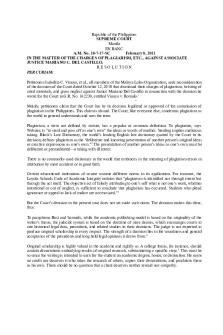Case Summary Re Ryan PDF

| Title | Case Summary Re Ryan |
|---|---|
| Course | Business And Company Law |
| Institution | Victoria University |
| Pages | 1 |
| File Size | 78.2 KB |
| File Type | |
| Total Downloads | 28 |
| Total Views | 152 |
Summary
Download Case Summary Re Ryan PDF
Description
In the case of Re: Colin Gregory Ryan [2014] QSC 18 the major issue is that Ryan (the applicant) is asking for a license to be involved in the management of CMI Limited , after being found guilty of three offences under section 58 of the Securities Act 1978 (New Zealand), and being disqualified of acting as a director of a corporation in Australia for a period of 5 years under section 206B of the Corporation Act 2001. The facts for this case are that Ryan acting as a non-executive director of CMF, a New Zealand’s public company, authorises to issue two advertisements that contained false statements, which lead to very large losses to the public. Although the offences were not for his personal benefit, he pleaded guilty but claimed that he had an honest believe that the statements were true, and the court found him negligent as he did not have reasonable grounds for his believes. Nevertheless, the applicant asks the court for a leave to participate in the direction of CMI. To make the decision the judge relied on Section 58 Securities Act 1978 (NZ), which defines the penalty to abide by being found guilty of misstatement in advertisement or registered prospectus. Section 206B Corporations Act 2001, which establishes disqualification from managing corporations for 5 years for offences committed in a foreign country when the offender does not serve term of imprisonment, section 206G Corporations Act, which defines the power of the court to grant a leave to manage corporations if the person was not disqualified by ASIC, the cases of Westgate Ports Ltd, in which it is said that one of the principles in considering an application of a leave to manage corporation, is that the policy of disqualification is to protect the public, and no to punish the offender, and ASIC v Adler (2002), which establishes that the purpose of the disqualification is also retribution, deterrence, reformation and contrition. The decision reached by the judge was to permit Ryan to participate in the management of CMI only if there are at least four additional directors and if CMI does not participate in business like those made by CMF. The reasons for granting the leave were firstly that CMI is a private company that does not reinvest. Secondly, although Ryan has a deep knowledge of CMI, he is not going to have the whole control of it as he would be one of the at least five of its directors. The risk of repetition of the offences is minimal as it was an exception to Ryan’s previous behaviour, as he is recognized by being integral, diligent, skilled, honest and ethical when managing other corporations. The ruling in this case is very significative for people in business as disqualified directors could be able to manage corporations if they can prove that the matter for the disqualification was a unique event and that they had a perfect behaviour when managing other corporations....
Similar Free PDFs

Case Summary Re Ryan
- 1 Pages

In re Andrews - Case Brief
- 1 Pages

Sample Case Note - Re Liveri
- 2 Pages

RYAN AIR
- 4 Pages

Carmichele Case - case summary
- 53 Pages

CASE summary - Case summarisa
- 3 Pages

Case summary
- 70 Pages

Case summary
- 2 Pages

LP FRAKTUR CRURIS RYAN
- 12 Pages

Prueba de Ryan resumen
- 4 Pages

Case Summary - contract b case
- 9 Pages

Ikea Case - Ikea case summary
- 1 Pages
Popular Institutions
- Tinajero National High School - Annex
- Politeknik Caltex Riau
- Yokohama City University
- SGT University
- University of Al-Qadisiyah
- Divine Word College of Vigan
- Techniek College Rotterdam
- Universidade de Santiago
- Universiti Teknologi MARA Cawangan Johor Kampus Pasir Gudang
- Poltekkes Kemenkes Yogyakarta
- Baguio City National High School
- Colegio san marcos
- preparatoria uno
- Centro de Bachillerato Tecnológico Industrial y de Servicios No. 107
- Dalian Maritime University
- Quang Trung Secondary School
- Colegio Tecnológico en Informática
- Corporación Regional de Educación Superior
- Grupo CEDVA
- Dar Al Uloom University
- Centro de Estudios Preuniversitarios de la Universidad Nacional de Ingeniería
- 上智大学
- Aakash International School, Nuna Majara
- San Felipe Neri Catholic School
- Kang Chiao International School - New Taipei City
- Misamis Occidental National High School
- Institución Educativa Escuela Normal Juan Ladrilleros
- Kolehiyo ng Pantukan
- Batanes State College
- Instituto Continental
- Sekolah Menengah Kejuruan Kesehatan Kaltara (Tarakan)
- Colegio de La Inmaculada Concepcion - Cebu



